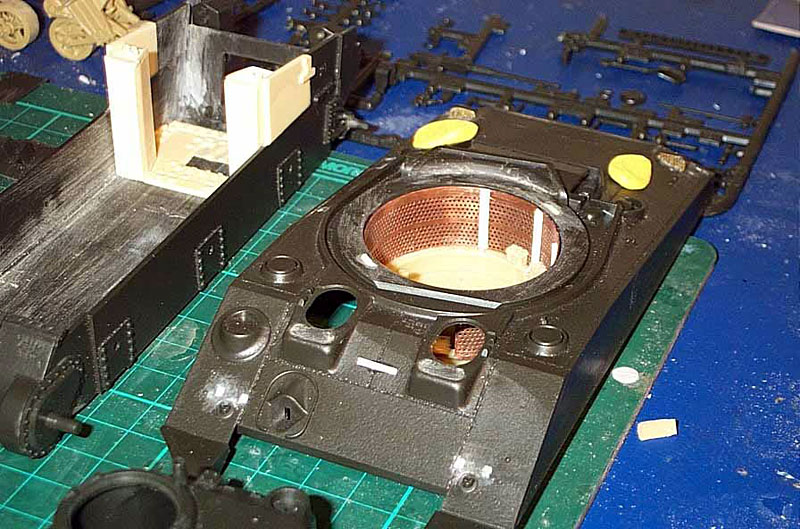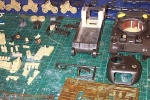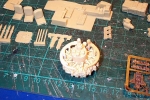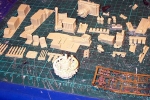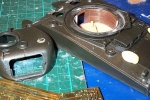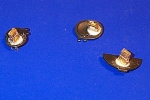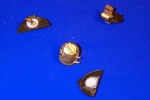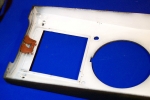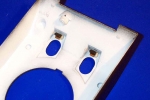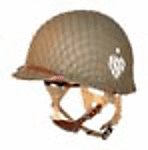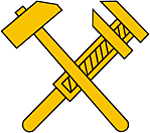1⁄35Tamiya M26 Dragon Wagon and M4 Sherman
14
Comments
Sherman
The M4 Sherman was started in sub assemblies again. To start off the bogie assembly’s and wheels had to be changed .The bogie arm assemblies are molded in 1 piece and the bogie is not movable. I changed the wheel assemblies to the Academy bogies because there was extra mold casting detail and movable arms .The drive sprocket shaft was replaced with a resin shaft .I wanted to show parts of the tank was damaged. By removing the drive sprocket it gave a better display of the damaged hull. The lower hull had a Tank Workshop radial engine and Verlinden Sherman interior . The firewall in between the engine and fighting compartments had to be sanded back considerably to make the 2 detail sets sit in the right spot. Most of the sanding was done on the Verlinden firewall because it was thinker than the Tank Workshop set. At this stage you have constantly try dry fitting the upper and lower plastic tubs ensuring all the components fit together. The upper hull was made with all the deck panels glued into position as per step 5 of the kit instructions .I left the engine hatch off because I wanted to portray the engine compartment open. Verlinden resin visors had been glued into the upper hull along with the plastic exhausts. It was here where I decided to tackle the all the episcope hatches. The plastic hatches had been dremelled out. ABER photo etch episcopes and holders had been used. On the inside of the circular episcope holder evergreen card was superglued on the inside to make it look thicker to scale. The center of the card was cut away to fit the episcope Aber folded brass episcopes had been folded with clear evergreen card for the visors. More evergreen card was used for the buffer pad just above the interior visor. This was a time consuming practice all up around 5-6 solid hours on the 3 visors. After this was done they had been dry fitted into the hatch and once I was happy with the positing they then got super glued in place. I then used a fine piece of wire rod and dropped Mr Surfacer 500 around the circular pieces to fill in any gaps.Comments
Beautiful work!
These were rated at 40 tons, but I've read that in practice they could haul a heavier load. Did these ever carry Pershings?
JAN 11, 2011 - 08:10 AM
Thanks Everyone for your kind words.They are appreciated .
Can I also add a special thanks to Darren and Kieth for their work to provide this article at Armorama.
My apologies I have no weathering progress photos as I have tried a variety of methods used on this vehicle which used various techniques from pastel chalks to Pigments and a small variation of mixing gyprock wall filler, acrylic paints and bird sand for the mud in the tire tracks.
I would like to share more articles in the weathering process in future articles throughout the year.
I'm glad you like the images.
Michael
JAN 11, 2011 - 07:37 PM
A stunning work Michael congrats, i'm very impressed
I'm sorry, probably you've already written it in the article, but how long did it take you to finish it?
I Always complain About my modelling slowness...If I were you I'd finish a similar work in about a century (and of, course with not the same results)
Cheers and congrats again
JAN 11, 2011 - 08:22 PM
Hi Mauro,
Thanks for your kind words.
The time it took to do this was a period of a good 9 months.
That was for both tank and Dragon Wagon.
The intention was to complete this and a diorama for Euro 2003
The diorama was partly started halfway through 2003 withe the dragon wagon.
I realised doing the groundwork on the dio that it was not going to be finished in time
The Dragon Wagon made Euro 2003 but was not completely finished .
It was another 12 months for weathering from using pigments and different weathering techniques during 2004
The final one was using faber castel pencil scratches and marks for the m26 and M4 .
And now ,you see the end result .
Michael
JAN 11, 2011 - 11:46 PM
Great looking combo Mike and a very insightful article. Thanks!
Cheers!
Stefan
JAN 12, 2011 - 04:33 AM
Yes i can see really stunning
On average, how many hours a week do you model ?
Did you give a primer coat on your models? (as i said, if you've already written in the text, i'm sorry in advance)
If yes, what primer did you use?
The m4 wreck seems to me incredible convincing and realistic
I think that modelling is not just a a matter of correct execution of techniques
I believe that just talent can make the difference between a "good model" and a "special one".Well, i'm happy 'cause here in Armorama i have the chance to see the works of many "talented" modellers. In my opinion you're one of them.
Cheers and thanks for share your work
JAN 12, 2011 - 11:07 AM
Thanks again Mauro and Stefan for your kind words.
modelling time per week could be anything up to 4 hours.
I am in the midst of completing a M2 Half track although this has taken far longer than anticipated.
I have been side tracked playing Bad Company on XBOX live and this does not help when you have cupboards full of models to build
The primer used on the 2 models would have been Humbrol No1 Matt primer.
I like Model Masters primer but have found when you do not use it for awhile it solidifies .
I only prime the parts or areas that need priming .I do not spray the primer all over the model.
Once primed I then airbrush the model with the base colour .
Michael
JAN 12, 2011 - 03:23 PM
As I thought. Using less primer is better
Thanks a lot for your explanations
I hope to see soon another of your work
cheers
JAN 12, 2011 - 07:35 PM
Copyright ©2021 by Michael Walsh. Images and/or videos also by copyright holder unless otherwise noted. The views and opinions expressed herein are solely the views and opinions of the authors and/or contributors to this Web site and do not necessarily represent the views and/or opinions of Armorama, KitMaker Network, or Silver Star Enterrpises. All rights reserved. Originally published on: 2011-01-10 00:00:00. Unique Reads: 38662




